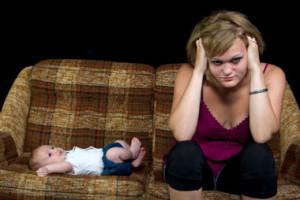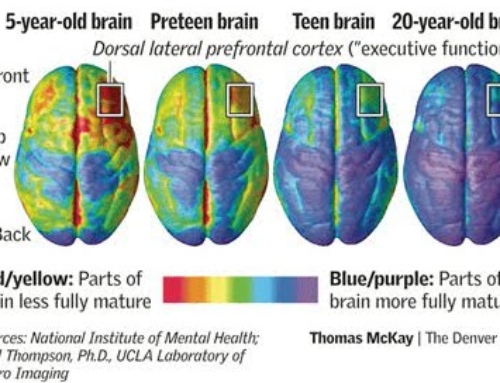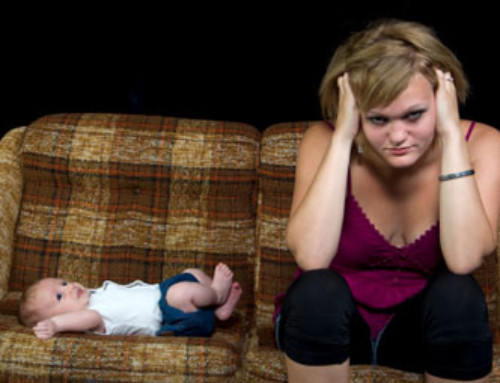I don’t know a person who doesn’t hate the sound of a crying baby. It can elicit feelings of helplessness, anger, frustration, and sadness. At times, we are utterly incapable of effectively stopping the crying which compounds these feelings even more. One of the biggest concerns in our society is something called “Shaken Baby Syndrome” whereby parents feel so helpless and frustrated at a child’s cry that they lash out and shake their baby. Obviously this isn’t good. But what to do?
Many intervention or prevention programs focus on simply putting baby down when it gets to that stage, but what about before that stage? Although I completely agree that if you feel you are about to harm your child, the absolute only thing to do is to put him/her down and give yourself a breather, we need more tips to help families not even reach that stage. After all, the importance of holding and responding to a baby while he or she cries is often the difference between the baby experiencing a cortical stress response or not (see here, and more in-depth here).
With that, I would like to share a few tips that I have learned along the way with numerous children who experienced bouts of crying that I could not alleviate in the moment, but remained holding them to provide comfort. One of the most important things that we often forget is that our children are as attuned to us as we are to them; if we are panicked and stressed while they cry, we can contribute to their distress and they are less likely to calm down. Remaining calm ourselves is critical to allow the synchronous relationship we hopefully have with them to help relax them when possible.
Take Turns
This isn’t possible for everyone, but whenever it is possible, it should be used. Switch it up before you hit the end of your rope. If you wait until you’re at the end of your rope, the time to recoup may be too long before it’s your turn again. Instead, take 15 or 30 minute shifts (depending on how long your baby cries for) and make sure you are away from the crying when you aren’t “on call”. Remember, it doesn’t have to be your partner but can be anyone that helps you out who your baby feels comfortable with (this part is key as the comfort element is with someone baby knows, however, even a responsive stranger is better than nothing); however, if it’s not someone baby knows well, taking a 5-10 minute breather may be exactly what you need and you should take it. Being in someone’s arms is better than being alone, but you may need to take more time than the secondary person.
Know You Are Helping Just by Holding
Sometimes all we need to make sure we don’t go crazy is the awareness that holding our child in a time of distress is helping even if it may not seem that way right away. When you can’t calm your crying baby it can feel like you’re helpless and, well, useless, but that is simply not true. Crying with support is essential to the well-being of our babies (you can read more here on the science behind it) and so knowing that you are providing that support will hopefully help bolster your ability to cope with these periods of crying. Furthermore, attempting to soothe a child, no matter how successful, actually predicts less crying in the long run.
Listen to Music (or Podcasts or Whatever Else) with Headphones
This was my go-to when my sister was young and had bouts of crying. I would give my mom a break and take over for her, holding my sister closely and rocking in the rocking chair or walking around, while listening to music. Music was my thing and I loved it and would always pick music that helped calm me (i.e., this was not the time I chose to listen to my punk rock). Earphones in and volume up, I could still hear the crying, but the music could be my focus, giving me the means to not go slowly insane.
I suppose in the day and age of tablets and smartphones, one could add watching TV to this. I would never recommend putting something on that baby can hear as sometimes the crying can be due to overstimulation of these types of gadgets, but if you have a tablet and some good earphones then you can watch and listen while holding and comforting your child. Note that there are good wireless earphones that can work too so you can use a laptop and not have wires hanging in baby’s face.
Take a Warm Shower (Yes, With Baby)
A warm shower would often calm my own daughter if she was upset, but even if it didn’t, the warm water, the skin-to-skin, the sound of the water all contributed to calming me. During the one period where my daughter had a few days of intense, prolonged crying due to a food allergy reaction, I could sit in the shower for 30-40 minutes with her. The water just helped keep me calm (as a nice warm shower does any other day I feel stressed). I would add bath to this too if you have a large and comfortable enough bath (which we don’t); the goal here is to do something that calms you and the skin-to-skin with your baby should help facilitate the physiological change for them as well.
Go For a Walk
Fresh air does most people good – even if it’s cold or raining. If you need to, bundle up, but baby wearing and going walking is wonderful for your state of mind and health too (the movement and closeness may have a shot at calming your baby as well). Being cooped up inside, especially with a crying baby, can make you go crazy. You’re staring at the same things, walking the same steps, and you slowly feel yourself losing it. Getting outside if at all possible changes that. You’re breathing fresh air, seeing new sights, and actually walking with purpose meaning you get a bit of a workout too (and we all know a workout releases endorphins that help you feel better too). Many people don’t do this because they fear people’s reactions to a crying baby out in public. Pardon the language, but fuck them. Your responsibility is to yourself and your child and no one said that people are entitled to nothing but quiet when outside. If you’re walking, you’re hardly close to any one person for any length of time either so you don’t need to worry about that. People will survive a slight inconvenience of a crying baby walking past them or their house whereas it may be a game changer for you.
***
When baby has calmed also remember to take care of yourself. If you need to vent or talk, call a friend (obviously this isn’t helpful when babe is still upset). Have a glass of wine. Do what you need to do to get back to “normal” after one of these events. Just always try to remember that you are being a responsive parent by being there for your baby and that you are not useless. Your caring and compassion is exactly what your baby needs to thrive. Remember: A happy baby isn’t one that never cries, but one that feels loved and cared for even in times of distress.







It’s statistically true that some babies cry more than others. That’s simply the way they’re wired. What we must give them is a ‘safe’ place to cry and that’s on somebody’s arms. I am a Certified Educator of Infant Massage and strongly believe, if a parent/caregiver learns to massage their baby properly from a certified instructor, NOT from so many of the insane You Tube clips, and are CONSISTENT, they will greatly reduce their baby’s need to cry. While learning the massage techniques, as I teach them, caregivers are made aware of their babies subtle and sometimes not-so-subtle clues as to what’s going on with them. It’s so incredibly helpful for amping down the stress-levels in both baby and parent. There’s so much more to this subject and not enough space to go on. I urge ALL new caregivers to bond with their babies by learning how to massage them from about 4 weeks on AND being consistent. The word is ‘CONSISTENCY!” <3
I love this blog and often refer to it in my Developmental Psychology class. We did many of these things with my daughter as a baby. Can you offer some tips on how to extend this to helping a toddler cope? I have a two year old daughter, and we can usually distract her from crying by gettgin her to take deep breaths, or acting silly or asking her lots of silly questions, quickly. However, I wonder if I’m still meeting her needs this way. She doesn’t always want to be held when she’s crying and hits sometimes, I think she feels overwhelmed at times.
Thanks!
What you describe is very normal. Toddlerhood is a time of violent behaviour in kids (regardless of how gentle we are) and developing autonomy. I don’t think distraction is necessarily helpful, but calming methods like deep breaths are very good. Sometimes they just need to cry though and being there to hold them through it is best. Letting them cry with comfort if it’s not something that can be “fixed” or you’ve set a boundary that needs to be maintained is okay. I spent a lot of time standing back just telling my daughter I was there when she was ready for me. Still do have to do that at times… 🙂
I got a wonderful tip once. Sit on the sofa and put your baby belly downwards on your thighs and stroke his/her back. That way you are comforting the baby but it doesn’t scream into your ear but rather at the floor. Has helped me in difficult situation.s I just wish my toddler would now lie still to do that instead of kicking :/
and that’s a form of massage, Lorena
..
@ Lorena … sorry, I should have given you this hint. If you don’t have sunflower oil use pure olive oil here. No lotions or greasy stuff.
Instead of reading a story/book to your toddler, surprise her be saying you’re going to tell a story on her back. Apply the oil to your hands and beginning at the base of her spine, using the fingertips of both hands, draw a tree growing (all the way up to her neck) – spread your fingers out on both shoulders and maybe down her arms, for the branches, Make up a story of the leaves blooming, the rain falling and nourishing the roots … and so on. It will be fun for both of you and a relaxant for your toddler. Eventually she can choose a theme and you can either let her tell the story while you massage it out, or you can make the new story up as you go.
It’s worked well for me. Think about it. Most of all, enjoy the process.
great post! could you please direct me to a reference for this: “attempting to soothe a child, no matter how successful, actually predicts less crying in the long run” is there research on this? thank you!
The earliest and most famous:
Bell SM & Ainsworth MSD. Infant crying and maternal responsiveness. Child Development (1972); 43: 1171-1190.
Hi, I’m curious about how this may relate to a baby crying in the car. I am so stressed to take him anywhere because he almost always cries. If my husband is there, I sit in the back and try to distract and comfort him. If I am alone, it is really difficult… Thankfully I never have a very long way to go, but when I do need to, would you recommend still talking/singing to him, or is it only touch that will prevent the increased cortisol levels? Thank you!
We don’t know a lot about non-touch, but there is evidence from apes that vocal calming can be helpful too. It’s just an area we don’t know. My daughter hated the car and would cry till she vomited and my son now hates the car (5 months of age) so I’m with you. I avoid as much as possible. Know that one day it will pass!
[…] Но еще важнее, чтобы как можно больше родителей знали о периоде гипореакции на стресс и о том, что поведенческий и физиологический ответ на стресс могут не совпадать. Именно тогда они будут понимать свою крайне важную роль в успокоении младенца, который будет им казаться безутешным (если вам нужна помощь, как справляться с таким плачем, вы можете почитать эти материалы). […]